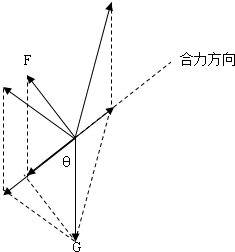问题
选择题
在匀强电场中将一个带电量为q、质量为m的小球由静止释放,小球的运动轨迹为一直线,此直线与竖直方向的夹角为θ,则匀强电场E的最小值是( )
A.mg q
B.mg•sinθ q
C.mg•cosθ q
D.mg•tanθ q
答案
由题小球做直线运动,受到重力G和电场力F的作用,则这两个力合力方向必须在此直线上,作出电场力在三种不同方向力的合成图如图,由数学知识得知,当电场力F与此直线垂直时,F最小,最小值为Fmin=Gsinθ=mgsinθ.
又F=qE,F最小时,则E也最小,所以匀强电场E的最小值是Emin=
=Fmin q
.mgsinθ q
故选B

